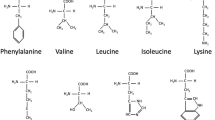Summary
Relationships between basal and fed metabolic rates and whole-body protein turnover rates were examined in three species of wallabies, the red-necked pademelon (Thylogale thetis), parma wallaby (Macropus parma) and tammar wallaby (M. eugenii).
There were no significant differences among wallaby species in basal metabolic rate (BMR) which was 30% below eutherian mammals. However, the fed metabolic rate of the tammar was lower than that of the other two species (P<0.05), as was the protein turnover rate (P<0.01) which is consistent with its lower voluntary feed intake and with its lower maintenance nitrogen requirement.
Protein turnover rates in the wallabies were 23–47% lower than in eutherian mammals. Similarly, protein synthesis made a lower contribution to fed metabolic rates in the wallabies (7–8%) than in eutherians (17–25%).
Thus, compared with several eutherian species, macropodid marsupials have low rates of both energy and protein metabolism, but within the macropodids there is not necessarily a close link between basal metabolic rate and whole-body protein turnover.
Similar content being viewed by others
Abbreviations
- BMR :
-
basal metabolic rate
- DEE :
-
daily energy expenditure
- EE :
-
energy expenditure
- LSD :
-
least significant difference
- RQ :
-
respiratory quotient
References
Barker S (1968) Nitrogen balance and water intake in the Kangaroo Island wallaby,Protemnodon eugenii (Desmarest). Aust J Exp Biol Med Sci 46:17–32
Blaxter KL (ed) (1965) Energy metabolism. Academic Press, London
Brody S (1945) Bioenergetics and growth. Reinhold Publ Co, New York
Brown GD, Main AR (1967) Studies on marsupial nutrition. V. The nitrogen requirements of the euro,Macropus robustus. Aust J Zool 15:7–27
Davis SR, Barry TN, Hughson GA (1981) Protein synthesis in tissues of growing lambs. Br J Nutr 46:409–419
Dawson TJ, Hulbert AJ (1970) Standard metabolism, body temperature, and surface areas of Australian marsupials. Am J Physiol 218:1233–1238
Dawson TJ, Denny MJS, Hulbert AJ (1969) Thermal balance of the macropodid marsupialMacropus eugenii Desmarest. Comp Biochem Physiol 31:645–653
Dellow DW, Harris PM (1984) Interdependence of energy and protein metabolism — a comparative marsupial-eutherian approach. In: Smith AP, Hume ID (eds) Possums and gliders. Aust Mammal Soc, Sydney, pp 107–113
Farrell DJ (1972) An indirect closed circuit respiration chamber suitable for fowl. Poultry Sci 51:683–688
Golden MHN, Jackson AA (1984) Assumptions and errors in the use of15N-excretion data to estimate whole body protein turnover. In: Waterlow JC, Stephen JML (eds) Nitrogen metabolism in man. Applied Science Publishers, London New Jersey, pp 323–344
Hoberman HD (1951) Measurements of rates of protein degradation and protein loss in fasting animals. J Biol Chem 188:797–804
Hume ID (1977) Maintenance nitrogen requirements of the macropod marsupialsThylogale thetis, red-necked pademelon, andMacropus eugenii, tammar wallaby. Aust J Zool 25:407–417
Hume ID (1982) Digestive physiology and nutrition of marsupials. Cambridge University Press, Cambridge
Hume ID (1986) Nitrogen metabolism in the parma wallaby,Macropus parma. Aust J Zool 34:147–155
Kempton TJ, Nolan JV, Leng RA (1979) The effect of supplementing a low protein cellulosic diet with either urea, casein or formaldehyde-treated casein in growing lambs. Br J Nutr 42:303–315
Kinnear JE, Purohit KG, Main AR (1968), The ability of the tammar wallaby (Macropus eugenii, Marsupialia) to drink sea water. Comp. Biochem Physiol 25:761–782
Kleiber M (1961) The fire of life. Wiley, New York
MacMillen RE, Nelson JE (1969) Bioenergetics and body size in dasyurid marsupials. Am J Physiol 217:1246–1251
MacRae JC, Lobley GE (1986) Interactions between energy and protein. In: Milligan LP, Grovum WL, Dobson A (eds) Control of digestion and metabolism in ruminants. Prentice-Hall, Englewood Cliffs, New Jersey, pp 367–385
Martin CJ (1903) Thermal adjustment and respiratory exchange in monotremes and marsupials—a study in the development of homoeothermism. Phil Trans R Soc Lond Ser B 195:1–37
McNab BK (1978) The comparative energetics of neotropical marsupials. J Comp Physiol 125:115–128
Milligan LP, McBride BW (1985) Shifts in animal energy requirements across physiological and alimentational status. J Nutr 115:1374–1382
Morrison PR (1951) An automatic manometric respirometer. Rev Sci Instrum 22:264–267
Nicholas GA, Lobley GE, Harris CI (1977) Use of the constant infusion technique for measuring rates of protein synthesis in the New Zealand white rabbit. Br J Nutr 38:1–17
Nolan JV, Leng RA (1972) Dynamic aspects of ammonia and urea metabolism in sheep. Br J Nutr 27:177–194
Picou D, Taylor-Roberts T (1969), The measurement of total protein synthesis and catabolism and nitrogen turnover in infants in different nutritional states and receiving different amounts of dietary protein. Clin Sci 36:283–296
Reeds, PJ, Fuller MF, Nicholson BA (1985) Metabolic basis of energy expenditure with particular reference to protein. In: Garrow JS, Halliday D (eds) Substrate and energy metabolism. John Libbey, London, pp 46–57
SAS (1985) SAS Institute Inc. Users' guide: Statistics, version 5th edn. Cory, North Carolina
Snedecor GW, Cochran WG (1967) Statistical methods, 6th edn. Iowa State University Press, Ames, Iowa
Sprinson DB, Rittenberg D (1949) The rate of interaction of the amino acids of the diet with the tissue proteins. J Biol Chem 180:715–726
Wallis R (1970) Metabolism and thermoregulation in the parma wallaby. Bull Aust Mammal Soc 2:202 (Abstract)
Waterlow JC (1984a) Methods of measuring protein turnover. In: Waterlow JC, Stephen JML (eds) Nitrogen metabolism in man. Applied Science Publishers, London New Jersey, pp 279–288
Waterlow JC (1984b) Protein turnover with special reference to man. Q J Exp Physiol 69:409–438
Waterlow JC, Garlick PJ, Millward DJ (1978) Protein turnover in mammalian tissues and in the whole body. Elsevier North Holland, Amsterdam
Author information
Authors and Affiliations
Rights and permissions
About this article
Cite this article
White, R.G., Hume, I.D. & Nolan, J.V. Energy expenditure and protein turnover in three species of wallabies (Marsupialia: Macropodidae). J Comp Physiol B 158, 237–246 (1988). https://doi.org/10.1007/BF01075838
Accepted:
Issue Date:
DOI: https://doi.org/10.1007/BF01075838




